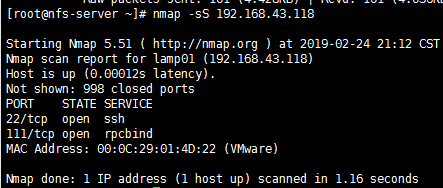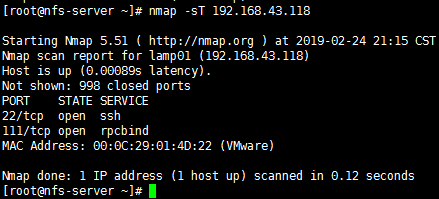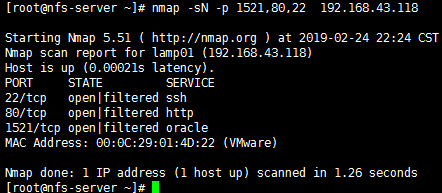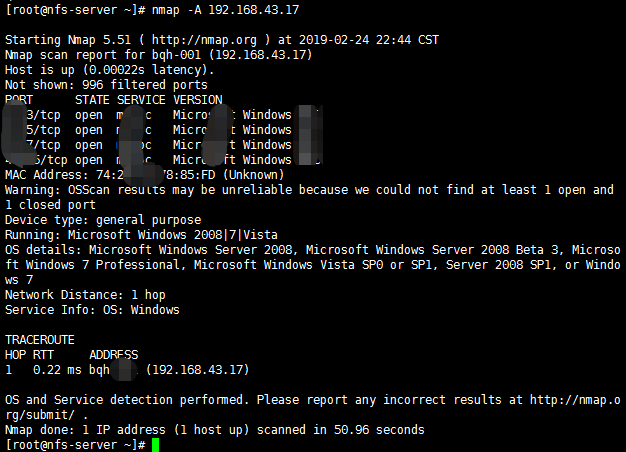Nmap是一款针对大型网络的端口扫描工具,被广泛应用于黑客领域做漏洞探测以及安全扫描,其主要功能有主机发现(Host Discovery)、 端口扫描(Port Scanning)、 版本侦测(Version Detection) 、操作系统侦测(Operating System Detection),可以适用于winodws,linux,mac等操作系统。
1、yum安装nmap
yum install nmap

nmap 命令参数:nmap -h
[root@lamp01 scripts]# nmap -h Nmap 5.51 ( http://nmap.org ) Usage: nmap [Scan Type(s)] [Options] {target specification} TARGET SPECIFICATION: Can pass hostnames, IP addresses, networks, etc. Ex: scanme.nmap.org, microsoft.com/24, 192.168.0.1; 10.0.0-255.1-254 -iL <inputfilename>: Input from list of hosts/networks -iR <num hosts>: Choose random targets --exclude <host1[,host2][,host3],...>: Exclude hosts/networks --excludefile <exclude_file>: Exclude list from file HOST DISCOVERY: -sL: List Scan - simply list targets to scan -sn: Ping Scan - disable port scan -Pn: Treat all hosts as online -- skip host discovery -PS/PA/PU/PY[portlist]: TCP SYN/ACK, UDP or SCTP discovery to given ports -PE/PP/PM: ICMP echo, timestamp, and netmask request discovery probes -PO[protocol list]: IP Protocol Ping -PR: ARP ping - does not need HW address -> IP translation -n/-R: Never do DNS resolution/Always resolve [default: sometimes] --dns-servers <serv1[,serv2],...>: Specify custom DNS servers --system-dns: Use OS's DNS resolver --traceroute: Trace hop path to each host SCAN TECHNIQUES: -sS/sT/sA/sW/sM: TCP SYN/Connect()/ACK/Window/Maimon scans -sU: UDP Scan -sN/sF/sX: TCP Null, FIN, and Xmas scans --scanflags <flags>: Customize TCP scan flags -sI <zombie host[:probeport]>: Idle scan -sY/sZ: SCTP INIT/COOKIE-ECHO scans -sO: IP protocol scan -b <FTP relay host>: FTP bounce scan PORT SPECIFICATION AND SCAN ORDER: -p <port ranges>: Only scan specified ports Ex: -p22; -p1-65535; -p U:53,111,137,T:21-25,80,139,8080,S:9 -F: Fast mode - Scan fewer ports than the default scan -r: Scan ports consecutively - don't randomize --top-ports <number>: Scan <number> most common ports --port-ratio <ratio>: Scan ports more common than <ratio> SERVICE/VERSION DETECTION: -sV: Probe open ports to determine service/version info -sR: Check what service uses opened ports using RPC scan --version-intensity <level>: Set from 0 (light) to 9 (try all probes) --version-light: Limit to most likely probes (intensity 2) --version-all: Try every single probe (intensity 9) --version-trace: Show detailed version scan activity (for debugging) SCRIPT SCAN: -sC: equivalent to --script=default --script=<Lua scripts>: <Lua scripts> is a comma separated list of directories, script-files or script-categories --script-args=<n1=v1,[n2=v2,...]>: provide arguments to scripts --script-trace: Show all data sent and received --script-updatedb: Update the script database. OS DETECTION: -O: Enable OS detection --osscan-limit: Limit OS detection to promising targets --osscan-guess: Guess OS more aggressively TIMING AND PERFORMANCE: Options which take <time> are in seconds, or append 'ms' (milliseconds), 's' (seconds), 'm' (minutes), or 'h' (hours) to the value (e.g. 30m). -T<0-5>: Set timing template (higher is faster) --min-hostgroup/max-hostgroup <size>: Parallel host scan group sizes --min-parallelism/max-parallelism <numprobes>: Probe parallelization --min-rtt-timeout/max-rtt-timeout/initial-rtt-timeout <time>: Specifies probe round trip time. --max-retries <tries>: Caps number of port scan probe retransmissions. --host-timeout <time>: Give up on target after this long --scan-delay/--max-scan-delay <time>: Adjust delay between probes --min-rate <number>: Send packets no slower than <number> per second --max-rate <number>: Send packets no faster than <number> per second FIREWALL/IDS EVASION AND SPOOFING: -f; --mtu <val>: fragment packets (optionally w/given MTU) -D <decoy1,decoy2[,ME],...>: Cloak a scan with decoys -S <IP_Address>: Spoof source address -e <iface>: Use specified interface -g/--source-port <portnum>: Use given port number --data-length <num>: Append random data to sent packets --ip-options <options>: Send packets with specified ip options --ttl <val>: Set IP time-to-live field --spoof-mac <mac address/prefix/vendor name>: Spoof your MAC address --badsum: Send packets with a bogus TCP/UDP/SCTP checksum OUTPUT: -oN/-oX/-oS/-oG <file>: Output scan in normal, XML, s|<rIpt kIddi3, and Grepable format, respectively, to the given filename. -oA <basename>: Output in the three major formats at once -v: Increase verbosity level (use -vv or more for greater effect) -d: Increase debugging level (use -dd or more for greater effect) --reason: Display the reason a port is in a particular state --open: Only show open (or possibly open) ports --packet-trace: Show all packets sent and received --iflist: Print host interfaces and routes (for debugging) --log-errors: Log errors/warnings to the normal-format output file --append-output: Append to rather than clobber specified output files --resume <filename>: Resume an aborted scan --stylesheet <path/URL>: XSL stylesheet to transform XML output to HTML --webxml: Reference stylesheet from Nmap.Org for more portable XML --no-stylesheet: Prevent associating of XSL stylesheet w/XML output MISC: -6: Enable IPv6 scanning -A: Enable OS detection, version detection, script scanning, and traceroute --datadir <dirname>: Specify custom Nmap data file location --send-eth/--send-ip: Send using raw ethernet frames or IP packets --privileged: Assume that the user is fully privileged --unprivileged: Assume the user lacks raw socket privileges -V: Print version number -h: Print this help summary page. EXAMPLES: nmap -v -A scanme.nmap.org nmap -v -sn 192.168.0.0/16 10.0.0.0/8 nmap -v -iR 10000 -Pn -p 80 SEE THE MAN PAGE (http://nmap.org/book/man.html) FOR MORE OPTIONS AND EXAMPLES
2、nmap 常用命令介绍:
扫描单个主机:
nmap 192.168.43.118
扫描单个子网主机:
nmap 192.168.43.0/24
扫描多个主机:
nmap 192.168.43.117 192.168.43.43.99
扫描一个范围内的主机:
nmap 192.168.43.1-254
若你有一个ip地址表,将ip地址存在ip.log文件中,命令如下:
nmap -iL ip.log
若你想查看扫描的所有主机列表命令如下:
nmap -sL 192.168.43.1/24
扫描一子网主机且排除某一个ip命令:
nmap 192.168.43.1/24 -exclude 192.168.43.118
扫描一子网主机且排除某一个ip地址表命令:
nmap 192.168.43.1/24 -exclude ip.log
扫描主机路由跟踪信息:
nmap --traceroute 192.168.43.118
扫描主机信息结果详细输出:
nmap -vv --traceroute 192.168.43.118
扫描某主机上指定的端口或协议,例如80,21,22
nmap -p U:53,T:80,21,22,S:9 192.168.43.118 (其中T代表TCP协议、U代表UDP协议、S代表SCTP协议)

快速扫描端口模式,扫描100个最有可能开放的端口 -v 获取扫描的信息
nmap -F -v 192.168.43.118

Tcp SYN Scan (sS) 隐蔽扫描
这是一个不完整的扫描方式,它被称为半开放扫描,Nmap发送SYN包到远程主机,但是它不会产生任何会话,在syn扫描中不需要通过完整3次的握手,因此不会在目标主机上产生任何日志记录,这个就是SYN扫描的优势,但是这种扫描是需要root权限(对于windows用户来说,是没有root权限这个概念的,root权限是linux的最高权限,对应windows的管理员权限)
nmap -sS 192.168.43.118

Tcp connect() scan(sT) 最常用
如果不选择SYN扫描,TCP connect()扫描就是默认的扫描模式,不同于Tcp SYN扫描,Tcp connect()扫描需要完成三次握手,并且要求调用系统的connect(),Tcp connect()扫描技术只适用于找出TCP和UDP端口,但是这种方式扫描的速度快,准确性高,对操作者没有权限上的要求,但是容易被防火墙和IDS(防入侵系统)发现。
nmap -sT 192.168.43.118

UDP scan(sU)
顾名思义,这种扫描技术用来寻找目标主机打开的UDP端口,它不需要发送任何的SYN包,因为这种技术是针对UDP端口的。UDP扫描发送UDP数据包到目标主机,并等待响应,如果返回ICMP不可达的错误消息,说明端口是关闭的,如果得到正确的适当的回应,说明端口是开放的。
nmap -sU 192.168.43.118
FIN scan (sF)
有时候Tcp SYN扫描不是最佳的扫描模式,因为有防火墙的存在,目标主机有时候可能有IDS和IPS系统的存在,防火墙会阻止掉SYN数据包。发送一个设置了FIN标志的数据包并不需要完成TCP的握手,收到RST回复说明该端口关闭,否则说明是open或filtered状态
nmap -sF 192.168.43.118
PING Scan (sP) 扫描在线主机
PING扫描它只用于找出主机是否是存在在网络中的,它不是用来发现是否开放端口的,PING扫描需要ROOT权限,如果用户没有ROOT权限,PING扫描将会使用connect()调用。
nmap -sP 192.168.43.118
版本检测(sV)
版本检测是用来扫描目标主机和端口上运行的软件的版本,它不同于其它的扫描技术,它不是用来扫描目标主机上开放的端口,不过它需要从开放的端口获取信息来判断软件的版本,使用版本检测扫描之前需要先用TCP SYN扫描开放了哪些端口。
nmap -sV 192.168.43.118
Idle scan (sL)
Idle scan是一种先进的匿名扫描技术,它不是用你真实的主机Ip发送数据包,而是使用另外一个目标网络的主机发送数据包,例如:通过目标网络中的192.168.43.118向主机192.168.43.4发送数据,来获取192.168.1.1开放的端口。
nmap -sL 192.168.43.118 192.168.43.4
有需要其它的扫描技术,如 FTP bounce(FTP反弹), fragmentation scan(碎片扫描),IP protocol scan(IP协议扫描),以上讨论的是几种最主要的扫描方式。
Nmap的OS检测(O)
Nmap最重要的特点之一是能够远程检测操作系统,Nmap的OS检测技术在渗透测试中用来了解远程主机的操作系统是非常有用的,通过获取的信息你可以知道已知的漏洞
nmap -O 192.168.43.17

ACK扫描:
利用ACK扫描判断端口是否被过滤。针对ACK探测包,为被过滤的端口(无论打开或关闭)会回复RST包
nmap -sA -T4 p1521,80 192.168.43.17
使用TCP ACK (PA)和TCP Syn (PS)扫描远程主机
nmap -pA -T4 p1521,80 192.168.43.17
nmap -pA -T4 p1521,80 192.168.43.17
扫描前不进行Ping扫描测试:
nmap -Pn p1521,80 192.168.43.17
通过tcp空扫描以绕过防火墙检测:
nmap -sN 192.168.43.17

打印主机接口和路由
nmap --iflist
按顺序扫描端口:
nmap -r 192.168.43.118
扫描主机检测是否有防火墙过滤:
nmap -PN -p 1521 192.168.43.17

扫描操作系统信息和路由跟踪
使用Nmap,你可以检测远程主机上运行的操作系统和版本。为了启用操作系统和版本检测,脚本扫描和路由跟踪功能,我们可以使用NMAP的“-A“选项。
nmap -A 192.168.43.17

扫描端口时状态介绍:
Open 端口开启,数据有到达主机,有程序在端口上监控
Closed 端口关闭,数据有到达主机,没有程序在端口上监控
Filtered 数据没有到达主机,返回的结果为空,数据被防火墙或者是IDS过滤
UnFiltered 数据有到达主机,但是不能识别端口的当前状态
Open|Filtered 端口没有返回值,主要发生在UDP、IP、FIN、NULL和Xmas扫描中
Closed|Filtered 只发生在IP ID idle扫描
以上总结来源于网络。